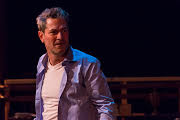Standing up for justice in a small Southern town: IRT has a new production of 'To Kill a Mockingbird'

A beloved book with a strong narrative voice at the center carries strong pluses and minuses over into a stage adaptation. On the one hand, there is the thrilling familiarity of the story and the characters in the flesh in front of us; on the other, there is a dilemma of what to do with that voice. It has to diminish somewhat to allow room to render recalled events in action. Jean Louse Finch (Lauren Briggeman) with the townsfolk she recalls as backdrop. First-person narration by a central character puts a novel on intimate footing with one reader at a time. This is the case with Scout when we read "To Kill a Mockingbird." How to minimize its loss in the theater? The solution behind the Christopher Sergel adaptation that Indiana Repertory Theatre opened this weekend is to have the adult Scout onstage, facing us, to capture much of the retrospective wisdom of the story the way Harper Lee wrote it. Lauren Briggeman presents Jean Louise Finch, to give her the name sh









